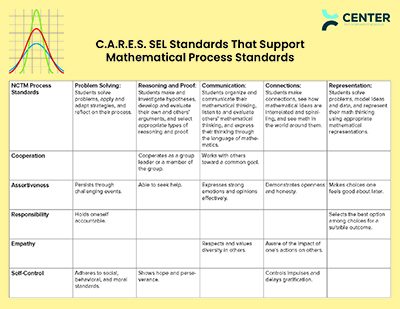by Omar Sillah
Studies have shown that curriculums implementing a social and emotional learning framework create a more equitable learning environment for students from diverse backgrounds and with diverse learning needs, and can eliminate the deep unseen barriers that might be preventing students from realizing their full potential. The positive findings of social and emotional learning on students’ academic and social development provide strong support for policymakers and school administrators to implement a SEL curriculum for students. Social-emotional learning should be viewed as critical to students’ success as are traditional classes like language arts, science, social studies, and especially mathematics.
Leveling the Playing Field Through an SEL Framework
SEL has been shown to be effective in addressing the social and academic needs of diverse groups of students. One study looked at the impact of an SEL program on students identified as at risk for emotional or behavioral problems in two large elementary schools in Florida and concluded that “SEL and literacy can lead to improvements in self-regulation that should enhance positive social and academic development” (Daunic et al., 2013, p. 49).
Studies have also shown SEL to be beneficial for students with various special learning needs (Cavioni et al., 2017; Espelage et al., 2016), including one that consisted of a racially diverse K–5 population where more than half of the participants received free or reduced lunch (Schonfeld et al., 2015). The SEL intervention program used in that school had a positive impact across all grade levels in reading, math, and writing.
Implementing SEL has proven to be beneficial for minority students. A study by Graves et al. (2017) consisted of students in an urban elementary school setting where over 90 percent of the students were identified as being of low social-economic status and African American. The SEL program used in this case was successful in developing students’ self-regulation and self-competence by a statistically significant margin.
Inequity in Mathematics
A crucial subject for careers in STEM fields, SEL has great potential to eliminate the current inequity in mathematics between different demographics of students. The Programme for International Student Assessment (PISA) survey, conducted every three years by the Organisation for Economic Co-operation and Development (OECD), found that “59% of the 15- to 16-year-old students reported that they often worry math classes will be difficult for them” (Luttenberger et al., 2018, p. 312), and another study found that young women and minority students are more inclined to be affected by math anxiety (Van Mier et al., 2019). However, a curriculum based on the foundational teachings of SEL, such as self-efficacy, has the potential to alleviate the math anxiety of students and enhance students’ academic achievement (Suárez-Pellicioni et al., 2016).
SEL and Eliminating Students’ Voice Disparity in Mathematics Classes
Discourse in the classroom where a student’s voice is encouraged is essential for their social development and academic success (Banse et al., 2016; Hammond, 2020; Van Zoest & Enyart, 1998). According to Hammond (2020):
In mathematics, though, it appears that teachers do utilize the power of discourse, for mathematics is viewed by some as a concrete subject. In a traditional mathematics class, the teacher tends to show students how to solve problems via some mathematical equation that is well defined over time, and different points of view of students might be mistakenly seen as unnecessary during classwork. However, it can be argued that a mathematics classroom based on students’ discourse can strengthen students’ understanding of mathematical concepts on a much deeper level, which will enable students to appreciate math because they now understand how mathematics is relevant to their daily lives. Paulo Freire, a Brazilian educator and philosopher, noted that one goal of education is to help students make sense of their environment so they can then transform their living conditions for the better (Freire, 1970).
Infusing SEL in a Mathematics Class
Effective strategies of infusing SEL content in classes includes:
- Socratic questioning techniques
- Lessons that encourage students to reflect
- Scaffolding
- Utilizing the real-life experience of students in course content
- Addressing students’ misconceptions
- Designing activities that encourage peer group discussions for students (Denham & Brown, 2010; Ee et al., 2013; Paul & Elder, 2003)
In addition to this, research by Ee et al. (2013) notes that staff should be provided professional development on SEL both before and during the implementation phase. The strategies outlined above create a positive school environment where each student’s voice and feelings are acknowledged and validated in classroom instruction by encouraging students to ask questions. For example, a teacher can encourage students’ participation by asking students clarifying questions:
- Can you tell me what you think about integrity? What is integrity?
- In order to cover one lie, what follows?
- If you get back the results on your test, and you realize that you have just passed with 15 marks, but that I had mistakenly given you 3 marks more, what will you do?
- So you say you won’t come forward to inform me about the mistake because you do not want to be retained. But marks provide objective feedback. What about that?
- How do you think your parents feel when you cheat? (Ee et al., 2013, p. 34)
Download an alignment map that shows how Center for Responsive Schools’ competencies and standards align with CASEL’s five core competencies.
Conclusion
At its core, the power of SEL is its advocacy of encouraging students’ voices in the classroom. This pedagogical philosophy is critical in addressing the needs of students because today’s students arrive in the classroom with enormous background knowledge because of advances in information technology. On the flip side, students today are also coming to the classroom with significant emotional challenges that may not have been present in previous generations, including self-image issues, cyberbullying, exposure to violence, and ubiquitous access to the internet. Policymakers and school administrators need to be aware that students’ social and academic needs are connected, and that both need to be addressed comprehensively if students are to reach their full potential.

Omar Sillah is completing his PhD in educational leadership at Mercer University in Atlanta, Georgia, and has a bachelor’s degree in economics from the University of Maryland, College Park. Currently, Omar teaches mathematics and leads an after-school financial literacy club for young people at an International Baccalaureate middle school in Atlanta.

